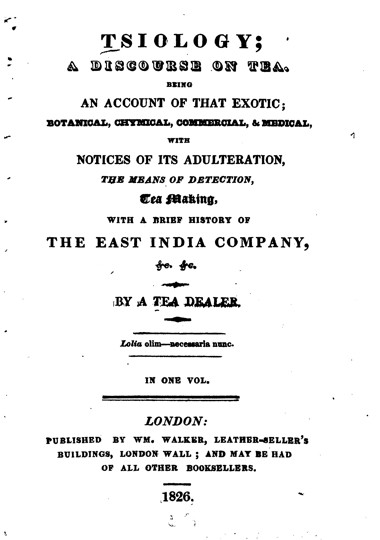Tsiology
In 1826, a small book was published in London bearing the curious name Tsiology; A Discourse on Tea. Like many previous treatises written in Europe, Discourse dealt with the nature of the exotic Asian plant Camellia sinensis and its leaf. Yet, no title on the subject of tea was ever so strange as Tsiology.
Lengthy subtitles provided the content of the book: “being an Account of that Exotic; Botanical, Chymical, Commercial, & Medical, with notices of its adulteration, the means of detection, Tea Making, with a brief history of The East India Company, etc.”[1] But the word “tsiology” was still difficult to fathom, and parsing the term merely hinted at a special branch of knowledge or science.
“Tsiology” defied discovery in the dictionaries of the day, but its exclusion from the English lexicon was easily explained: the word was pure invention. Expressly coined for the book, “tsiology” appeared just once in the title and not at all in the text,[2] leaving the origin and true meaning of the term a profound mystery. That the author, “A Tea Dealer,” remained cloaked in anonymity further muddled the matter.
Nonetheless, Tsiology briefly intrigued London readers with its veneer of erudition, the novel work and title lasting through three editions printed over a year or so.[3] Although the book dealt with several important and timely issues of the British tea trade, “tsiology” never gained popularity as an expression of tea, and indeed it all but disappeared from the common English language.
Notes
[1] The full title of the book read Tsiology; A Discourse on Tea, being an Account of that Exotic; Botanical, Chymical, Commercial, & Medical, with notices of its adulteration, the means of detection, Tea Making, with a brief history of The East India Company, etc. For a list of early books on tea, see John Coakley Lettsom (English, 1744–1815), The Natural History of the Tea-Tree (London: Edward and Charles Dilly, 1772), pp. 8-12.
[2] “Tsiology” was used as the title twice in the book: once on the half title page and then on the title page.
[3] Alfred Rehder (American, 1863-1949), The Bradley Bibliography: A Guide to the Literature of the Woody Plants of the World Published Before the Beginning of the Twentieth Century (Riverside Press, 1915), vol. 3, p. 606.

